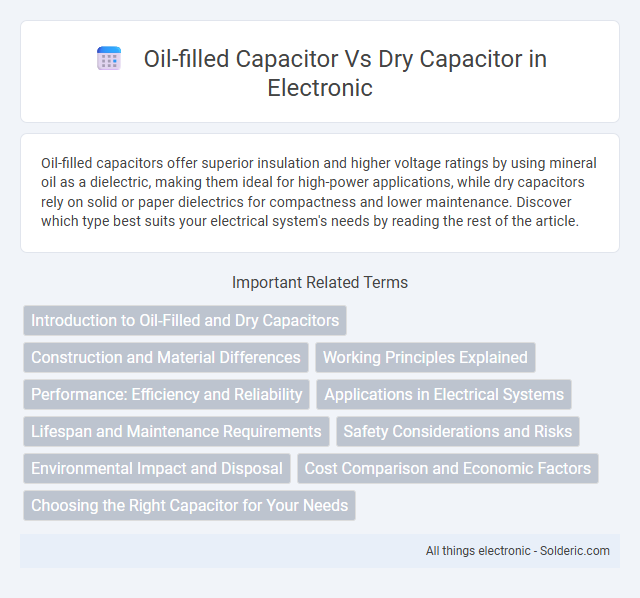Oil-filled capacitors offer superior insulation and higher voltage ratings by using mineral oil as a dielectric, making them ideal for high-power applications, while dry capacitors rely on solid or paper dielectrics for compactness and lower maintenance. Discover which type best suits your electrical system's needs by reading the rest of the article.
Comparison Table
| Feature | Oil-Filled Capacitor | Dry Capacitor |
|---|---|---|
| Dielectric Medium | Mineral oil or synthetic oil | Solid dielectric (paper, plastic, ceramic) |
| Insulation | Oil provides high insulation and cooling | Solid insulation materials |
| Thermal Management | Excellent heat dissipation via oil | Limited heat dissipation capability |
| Size | Generally larger and heavier | Compact and lightweight |
| Leakage Risk | Possible oil leaks and environmental hazards | No leakage risk |
| Maintenance | Requires periodic oil checks and replacement | Minimal maintenance |
| Applications | High voltage, power factor correction, industrial use | Consumer electronics, low voltage applications |
| Cost | Higher initial cost and maintenance | Lower cost and easy installation |
| Reliability | Good for high stress, but oil aging affects lifespan | Stable performance with longer life expectancy |
Introduction to Oil-Filled and Dry Capacitors
Oil-filled capacitors use mineral oil as a dielectric medium, offering superior insulation and higher capacitance stability under varying temperatures and voltages. Dry capacitors, typically constructed with solid dielectrics such as ceramic, film, or plastic, provide better environmental safety and reduced maintenance requirements. The choice between oil-filled and dry capacitors depends on application demands including voltage ratings, thermal performance, and reliability considerations.
Construction and Material Differences
Oil-filled capacitors utilize impregnated paper or plastic film immersed in insulating oil, providing superior electrical insulation and heat dissipation, making them suitable for high-voltage and high-frequency applications. Dry capacitors, typically made with ceramic, polyester, or polypropylene materials, rely on solid dielectric substances without liquid insulation, resulting in a more compact and less maintenance-intensive design. Your choice between these types should consider the trade-offs in durability, thermal stability, and application demands based on the construction and material differences.
Working Principles Explained
Oil-filled capacitors utilize a dielectric oil that enhances insulation and heat dissipation by immersing the capacitor plates in a liquid medium, which reduces the risk of arcing and improves voltage stability. Dry capacitors, on the other hand, rely on solid dielectric materials such as ceramic, polyester, or polypropylene films, providing a compact and maintenance-free design with better resistance to environmental changes and lower leakage currents. The dielectric fluid in oil-filled capacitors allows for higher capacitance and voltage ratings, whereas dry capacitors offer superior frequency response and are commonly used in applications requiring quick charge and discharge cycles.
Performance: Efficiency and Reliability
Oil-filled capacitors generally offer higher efficiency and superior reliability due to their enhanced dielectric properties and better heat dissipation compared to dry capacitors. Their oil impregnation reduces electrical losses and helps maintain stable performance under high voltage and temperature conditions. Your choice of capacitor will depend on the application's demand for long-term stability and consistent efficiency.
Applications in Electrical Systems
Oil-filled capacitors excel in high-voltage power transmission, industrial machinery, and power factor correction due to their superior dielectric strength and thermal stability. Dry capacitors, commonly used in consumer electronics, lighting circuits, and audio equipment, offer compact size and environmental safety without the risk of oil leakage. Your choice depends on the application's voltage requirements, environmental conditions, and maintenance preferences, ensuring optimal performance and reliability.
Lifespan and Maintenance Requirements
Oil-filled capacitors typically offer a longer lifespan due to superior insulation and cooling properties, reducing the risk of dielectric breakdown over time. Dry capacitors require less maintenance as they do not contain liquid that can leak or degrade, making them more suitable for environments where regular upkeep is challenging. Choosing the right capacitor for your application depends on balancing longevity with maintenance capabilities to ensure optimal performance.
Safety Considerations and Risks
Oil-filled capacitors have enhanced dielectric strength and better heat dissipation, reducing the risk of electrical breakdown and fire hazards compared to dry capacitors. However, the presence of insulating oil poses potential environmental and health risks in case of leakage or rupture, requiring careful handling and disposal. Dry capacitors, while safer from leakage concerns, may have lower thermal tolerance and can be more prone to explosive failure under severe electrical stress, necessitating rigorous quality control and protective measures.
Environmental Impact and Disposal
Oil-filled capacitors often contain polychlorinated biphenyls (PCBs) or other hazardous oils, posing significant environmental risks if leaked or improperly disposed of, requiring specialized recycling and disposal processes. Dry capacitors, made with solid dielectrics such as ceramic, polyester, or polypropylene, have a lower environmental impact and are easier to recycle or safely discard. Proper handling and adherence to environmental regulations are critical to minimizing pollution and health hazards associated with capacitor disposal.
Cost Comparison and Economic Factors
Oil-filled capacitors generally have a higher initial cost compared to dry capacitors due to their complex construction and superior insulation properties. However, oil-filled capacitors often offer better longevity and reliability in high-voltage or high-temperature applications, potentially reducing long-term replacement and maintenance expenses. Dry capacitors typically provide a more cost-effective solution for lower voltage or less demanding environments, where budget constraints prioritize upfront cost savings over extended service life.
Choosing the Right Capacitor for Your Needs
Oil-filled capacitors offer superior insulation and higher voltage ratings, making them ideal for high-power industrial applications requiring durability and reliability. Dry capacitors, characterized by their lower weight and environmental safety, suit consumer electronics and smaller-scale circuits where compact size and maintenance-free operation are priorities. Selecting the right capacitor depends on factors such as voltage requirements, environmental conditions, size constraints, and application-specific performance standards.
oil-filled capacitor vs dry capacitor Infographic

 solderic.com
solderic.com